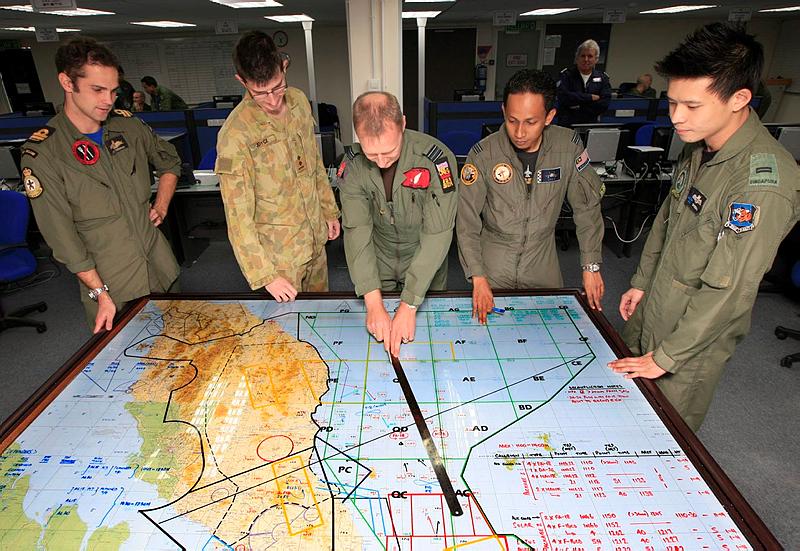A Strategist retrospective: the future of the Five Power Defence Arrangement
Posted By Tim Huxley on December 30, 2013 @ 06:00
This post was originally published on November 8, 2012
(The Strategist will return with new material on January 6, 2014 – Ed.)
 [1]
[1]The Five Power Defence Arrangements (FPDA) is often overlooked as a regional security institution, and is a curious security device that embodies several paradoxes. The Arrangements’ most important roles are not discussed openly. And the most important non-regional player in the FPDA is not necessarily the one which plays the most prominent role in terms of its conventional military commitment. Moreover, while the FPDA is apparently anachronistic, in reality it continues to serve vital security roles and will do so in the future.
To expand on the first of these paradoxes: the FPDA is often characterised as a Cold War leftover that is irrelevant to the current and future security concerns of regional states. However, while the FPDA was created during the Cold War in the context of the military withdrawal by the UK from Southeast Asia in the late 1960s and early 1970s, its key roles were never Cold War specific. The five powers involved have always held diverse motives for participating in the Arrangements. However, discussion of two of the FPDA’s core rationales has always been essentially taboo.
The first of these implicit roles has been for the FPDA to act as a hedge against a resurgence of an unstable and threatening Indonesia which might endanger the security of Malaysia and Singapore, and perhaps also the wider sub-regional balance of power to the detriment of Australia, New Zealand and maybe the United Kingdom. While this has not been a realistic or immediate prospect since the FPDA was established in 1971, the ouster of Indonesia’s President Suharto in 1998 and the ensuing instability there over the following three to four years may have reminded FPDA members—particularly Malaysia and Singapore—of the origins of the Arrangements after Jakarta’s Konfrontasi of 1963–6. And while Indonesia’s trajectory in terms of domestic stability and its willingness to play a constructive role regionally and internationally has seemed encouraging under the leadership of President Susilo Bambang Yudhoyono, there remain disquieting domestic political trends that could lead to the world’s fourth most populous country becoming a less congenial neighbour in the future.
The FPDA’s second implicit role has been to maintain essential channels of communication on defence and military matters between Malaysia and Singapore, and to build strategic confidence between these two Southeast Asian states whose sporadic mutual distrust sometimes highlights underlying existential tensions.
Neither of these FPDA roles can be discussed openly in Southeast Asia, for fear of further undermining sometimes strained relations within the Indonesia–Malaysia–Singapore triangle. Nevertheless, in recent years the five powers have displayed considerable flexibility in interpreting the FPDA’s security ambit, notably adapting their exercise series in response to strategic concerns du jour, such as terrorism and humanitarian assistance and disaster relief (HADR). These exercises have doubtless helped to build a degree of interoperability between the forces of FPDA members, which has sometimes proved useful operationally outside the FPDA context. This was certainly true in the Australian-led intervention and security presence in East Timor from 1999: ultimately, forces from all FPDA member-states were deployed in the territory. Familiarity deriving from FPDA contacts might also have helped some FPDA member-states’ armies to operate alongside each other in Afghanistan.
Turning to the second paradox, it is clearly Australia that has played the most active role among the three extra-regional FPDA participants, both diplomatically and in terms of its contribution of forces to FPDA exercises. The UK has never contributed either diplomatic enthusiasm or forces to the FPDA on the scale of Australia, and the British government’s Strategic Defence and Security Review (SDSR) in 2010 further undermined the UK’s capacity to project expeditionary military power. However, successive UK governments’ commitment to perpetuating the UK’s status as one of five permanent UN Security Council members, and as a nuclear-weapons state maintaining a strategic second-strike capability is often overlooked in the Asia-Pacific region. The UK’s continuing involvement in the FPDA, which notably survived the 2010 SDSR, is significant for its FPDA partners and for other regional states because of Britain’s continuing diplomatic and strategic weight.
One of the most frequently-heard comments about the FPDA is that it is ‘out-dated’. Putting aside its possible continuing relevance in the immediate vicinity of Malaysia and Singapore, the changing strategic environment in the wider Asia-Pacific region suggests a range of adverse future scenarios in which membership of the FPDA could valuably supplement member states’ other external security arrangements. All signs are that the Asia-Pacific region’s strategic environment will be characterised by these major features:
- further shifts in the distribution of power as the strategic weight of China increases (India seems less certain) relative to the US
- potential flashpoints for state-on-state conflict, including the Taiwan Straits, the Korean peninsula and the waters around China including the South China Sea
- increased likelihood of conflict over scarce resources, particularly in the maritime sphere
- increased pressure on already fragile states due to climate change
- offensive military capability build-ups
- weak multilateral regional security institutions with little capacity to mitigate regional tensions and conflicts
- mini-lateral security relations rather than formal alliances
Against this backdrop, the FPDA—with its mix of regional and extra-regional member-states, lack of formal alliance commitments, and proven adaptability—hardly seems anachronistic. Rather, it is particularly well-suited to the likely future strategic circumstances. The FPDA is a non-provocative form of hedging and confidence-building, and it would be surprised if any of the participating member-states chose to discard their FPDA commitments or contributions.
Tim Huxley is executive director of the International Institute for Strategic Studies (Asia). Image courtesy of Department of Defence [2].
Article printed from The Strategist: https://aspistrategist.ru
URL to article: /a-strategist-retrospective-the-future-of-the-five-power-defence-arrangement/
URLs in this post:
[1] Image: https://aspistrategist.ru/wp-content/uploads/2012/11/20101026raaf8165233_0695-1.jpg
[2] Department of Defence: http://images.defence.gov.au/20101026raaf8165233_0695.jpg
Click here to print.